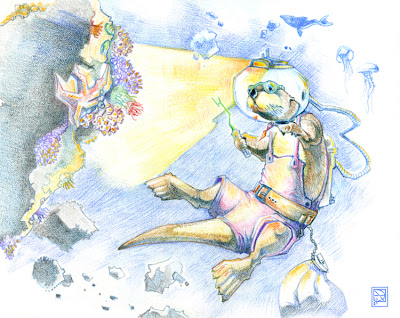It's a fairly common occurrence, when I'm out and about, to be asked about what I "do" for a living. The typical reaction I get when I say, "I'm an illustrator who works on children's books and comics," is a pretty universal response, along the lines of "that must be fun!" I don't disagree with this statement. I mean, it's truly an amazing and rare thing to be trying to make a living doing what you love. However, I agree--with reservations.
It seems in the illustration market lately, the prevailing attitude of "that must be fun!" also equates to a quick devaluing of all the times when the job is not only fun, but work as well. When you work through an illustration that you truly love, there is always a lot of time committed to a piece before it becomes an image someone looks at and says, "Wow! That must have been fun to make!" ...Understanding this, I thought I'd devote this blog to a quick examination of my process when creating any work that will still hold up after time.

Everything of any importance starts as a thumbnail or rough sketch. As a younger artist, I operated under the false impression that working straight from the mind to the page was the "purest" way to achieve any "true piece of art." Only after looking at many finished illustrations that had been erased and drawn over too many different times, did I appreciate the power of a few pages of preliminary sketches and a good thumbnail. For me the thumbnail is a time saver, not a time waster. By the time I break out the blank page, I've already worked out the major elements on the page: the camera angle, the format, and in some more detailed instances, a sense of light for the piece. Total working time for the preliminary sketches and thumbnail usually takes about an hour or two.
The example above is the rough I created as an assignment for an SCBWI conference. The project was a double-page spread devoted to a selected passage from Snow White. I added the calligraphic border element in the top left to give a sense of showing two scenes without overpowering the main image that stretches across both pages. While it was important to show Snow White fleeing through the woods, I found it to be more integral to the storytelling to show the moment of relief when Snow White emerges from the dark, creepy woods to find the dwarves home.

If I were more of a painter, this finished line image would be a moot point. But, considering my background in sequential art and comics, I'm still married to a solid line drawing. You can see the image of Snow White has changed a bit from the rough. I've also moved the dwarves' house behind the tree line that Snow White is emerging from. This decision had everything to do with feedback from the coordinator of the SCBWI class where the assignment would be presented.
While it hasn't changed much from the rough stage, the major work was more taking the thumbnail and blowing it up to a 12x18 size. I drew the image in pencil first and then proceeded to ink the piece using a combination of brush and pen. My only advice to any one out there who loves line is: become just as good at inking your work as you are with your pencils. Unless you are a phenomenally amazing draftsman with the pencil, learning how to ink your work makes you a double threat, and therefore able to command higher prices in some industries. Happy with the result and the four to six hours devoted to this step, I move on to the more finished color illustration...

The major mistake made between the line work and the color phase had everything to with the ink in some of the tools I used to create the line. When working in water-based medium (watercolor), it's always a good idea to make sure the line you're painting over won't smudge or run (i.e., is waterproof), and in the case of this illustration, some of the line work wasn't. I dealt with this problem by applying a coat of a workable matte fixative. It renders the surface waterproof (mostly) but also can be problematic when trying to achieve smooth watercolor washes. While I was not pleased by this annoying misstep, I worked around it to create the finished image you see here on the screen. I'm happy with the results. The total time spent working on this step was another four to six hours.
So... taking all these steps into consideration, the total working time for this piece was anywhere between twelve to sixteen hours... It has become work. When that "fun" idea takes more than two full work days to complete, it becomes work. Don't get me wrong, I love telling stories through imagery, it's amazing, but when a person equates this "work" to something "fun" it devalues the sixteen hours spent creating the work. Most artists are creating art for much less than they should--because of this attitude. Ask anyone trying to pay the bills doing this. It's not that there aren't projects to be made. It's trying to get paid an asking price that doesn't undercut the next guy waiting in line...
So... if you see me out and about, and you ask me, "What do you do for a living?" don't read too much into my wry smile after you tell me, "Wow, that must be so fun!!" I agree, but with reservations.
Stay Tuned
Daniel DePaolo


















































